Sea Grant has released an Oil Spill Science Outreach publication discussing what happened to the oil that reached the Gulf of Mexico beaches in the aftermath of the Deepwater Horizon oil spill.
The bulletin is found here

Sea Grant has released an Oil Spill Science Outreach publication discussing what happened to the oil that reached the Gulf of Mexico beaches in the aftermath of the Deepwater Horizon oil spill.
The bulletin is found here
Biodegradation? Chromatography? While scientists toss these terms around with no problem, they can sound like a foreign language to others.
The Deep-C consortium partnered with CPALMS, an online toolbox providing free instructional resources for educators, to create a series of videos related to Deepwater Horizon research and the Gulf Oil Observers (GOO) project.
High School Students Work Alongside Woods Hole Experts
Watch how these high school students work alongside Woods Hole Oceanographic Institution experts conducting oil spill science. A CPALMS perspective Video by Catherine Carmichael.
Don’t cry over spilled oil. Take action instead!
Learn how scientists are studying what happens to spilled oil and over time how it affects the environment. A CPALMS perspective video by Catherine Carmichael.
How Crude Oil is Formed and How it Behaves in the Environment
Chris Reddy, an oil scientist at Woods Hole Oceanographic Institution and research for DEEP-C, explains how crude oil is formed and how it behaves in the environment. A CPALMS perspective Video by Chris Reddy.
Using Oil Fingerprints to Explain the Origins of Spilled Oil
Humans aren’t the only ones who get their fingerprints taken. Learn how this scientist is like a crime scene investigator using oil fingerprints to explain the origins of spilled oil. A CPALMS perspective Video by Chris Reddy.
High School Teacher Holds Class on the Beach
What could be better than having class on the beach and conducting actual research to boot? See how Shawn Walker, a marine science teacher at West Florida High School, transforms his students into scientists. A CPALMS perspective Video.

Deepwater Horizon oil impacted over 1,700 km of Gulf of Mexico coastline and prompted 89 beach closures, largely due to uncertainty about health risks associated with oil contamination. Compared to adults, children spend more time in the sand when at the beach and touch their face more often, increasing potential exposure to contaminants through skin contact or ingestion. Tanu Altomare analyzed data quantifying children’s beach behaviors to inform a model evaluating health risks to young children when playing on oil-contaminated beaches. Responders can use the model’s assessments when making decisions about beach closures and communicating risks to the public when future pollutant events happen.
Tanu was a Ph.D. student with the University of Texas Health Science Center at Houston’s School of Public Health and a GoMRI Scholar with the project Beach Exposure And Child HEalth Study (BEACHES).
Her Path
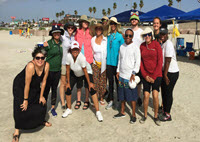
When Tanu was a microbiology student at the University of Houston-Downtown, a guest lecturer discussed environmental risk assessments of pollutants in or near residential homes. Tanu had been conducting laboratory experiments but wondered if the long stretches without human interaction were right for her. By contrast, the lecturer’s work that combined environmental science, epidemiology, and social and behavioral science fascinated her.
While researching graduate schools, Tanu toured the School of Public Health at the University of Texas Health Science Center at Houston and subsequently accepted a graduate research position toward a Master of Public Health. She worked closely with Dr. Kristina Mena investigating the factors influencing microbial load (the number and type of microorganisms contaminating a water body) in two Galveston Bay marinas and hoped to complete a doctorate under her mentorship. Tanu described her research interests to Dr. Mena, who recommended the GoMRI-funded BEACHES project exploring how interactions between people’s behavior and the environment influence their health – concepts that first got Tanu interested in public health.
“I’ve lived in Houston for nearly 20 years, and I’ve been present for a variety of natural and man-made disasters, including Hurricane Harvey and the Deepwater Horizon spill,” said Tanu. “I’ve seen firsthand how those events affected my community, so I’ve always had a personal stake in better understanding the effects of disaster and behavior on health and wellbeing.”
Her Work
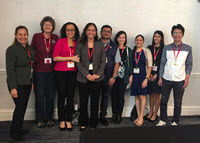
The BEACHES team is developing an assessment platform that will provide health risk information on children playing at oil-contaminated beaches. The model currently uses benchmarks established in the Environmental Protection Agency (EPA) Exposure Factors Handbook to determine health risk, but real-time data will help refine these benchmarks so that they are applicable to children of different ages, genders, and demographics. Tanu and her fellow BEACHES researchers video recorded children (with guardian permission) playing in Florida and Texas beach sands over a ten-day period. The team monitored behaviors that would affect children’s exposure risks, especially how often they touched their mouths, the frequency and length of time they spent in water and sand, and how much sand stuck to their hands and bodies when their skin was wet, dry, or had sunscreen on it.
Tanu analyzed the video data using a risk assessment software called Crystal Ball, which returns a best-case, worst-case, and most likely outcome for a scenario. Her preliminary analyses suggest that exposure frequency (how many days per year children go to the beach) had the greatest influence on health risk estimates out of the factors analyzed so far. This observation supports the expectation that factors with a wide range of variability like exposure frequency will influence risk estimates more strongly than variables like body weight or skin surface area, which show little fluctuation among children. However, she is eager to see how estimates change once data on soil intake rate (oral exposure), adherence factor (skin exposure), and inhalation rate are incorporated into the model.
“I think this model will be especially useful for agencies involved in communicating advisories and other health information to the public. Instead of blanket advisories, they can provide a more thorough explanation of how and why the public should or should not avoid certain beach-related activities following a disaster event,” said Tanu. “For example, [the observations about exposure frequency] can be valuable for families living in Gulf communities, because they tend to visit beaches more often than families who only go once or twice a year.”
Her Learning
Working with an interdisciplinary group showed Tanu how real-world science unfolds, with researchers relying on each other to fill in different pieces of a larger puzzle. A memorable moment for Tanu was hearing Dr. Alesia Ferguson’s observations about their video recordings, who commented that children behaved differently depending on if their mother, father, or siblings were present and that there were behavioral trends for children of different racial backgrounds. “At that moment, the multitude of factors that play into how a person interacts with their environment really hit home,” said Tanu. “Sometimes, I get narrowly focused on the scientific parts of the equations, like the chemical concentrations, but there is a human factor that has a profound effect on health outcomes.”
As a member of the GoMRI community, Tanu interacted with an extensive network of researchers, policymakers, and industry leaders. When she began her doctoral research, Tanu anticipated that her advisor would be her main mentoring resource, but she also received feedback from many GoMRI community members. She attended a graduate student luncheon at the 2020 Gulf of Mexico Oil Spill and Ecosystem Science Conference, where she engaged with fellow students and experts from diverse fields. “The leaders of GoMRI have taught me a lot of what it means to be a researcher and collaborator,” she said. “The most important piece of advice I received at the luncheon was to always be open to new projects and opportunities, because it opens up so many new avenues for research and networking.”
Tanu also learned the importance of talking with her advisor about the future, even when she wasn’t sure what she wanted to do. “A lot of students know they want to pursue a career in science but don’t know all their options, and that can be frustrating,” she said. “I had a vague, almost incoherent idea what I was interested in, but Dr. Mena helped me form a concrete idea. She took my interests and connected it to an awesome project!”
Tanu completed her Public Health doctorate and is seeking opportunities where she can continue working with the marine environment and children’s health.
Praise for Tanu
Dr. Mena described Tanu as an engaging student and a forward-thinking researcher, who asks the right questions about things that others may overlook. “Tanu was an integral part of the field work for this study as well as the risk assessment component,” she said. “She was not only a remarkable student, but she is also an exceptional person. I look forward to hearing about her future contributions.”
The GoMRI community embraces bright and dedicated students like Tanu Altomare and their important contributions. The GoMRI Scholars Program recognizes graduate students whose work focuses on GoMRI-funded projects and builds community for the next generation of ocean science professionals.
By Stephanie Ellis and Nilde Maggie Dannreuther. Contact sellis@ngi.msstate.edu for questions or comments.
************
The Gulf of Mexico Research Initiative (GoMRI) is a 10-year independent research program established to study the effect, and the potential associated impact, of hydrocarbon releases on the environment and public health, as well as to develop improved spill mitigation, oil detection, characterization and remediation technologies. An independent and academic 20-member Research Board makes the funding and research direction decisions to ensure the intellectual quality, effectiveness and academic independence of the GoMRI research. All research data, findings and publications will be made publicly available. The program was established through a $500 million financial commitment from BP. For more information, visit http://gulfresearchinitiative.org/.
© Copyright 2010-2020 Gulf of Mexico Research Initiative (GoMRI) – All Rights Reserved. Redistribution is encouraged with acknowledgement to the Gulf of Mexico Research Initiative (GoMRI). Please credit images and/or videos as done in each article. Questions? Contact web-content editor Nilde “Maggie” Dannreuther, Northern Gulf Institute, Mississippi State University (maggied@ngi.msstate.edu).
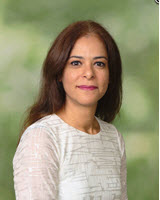
The Deepwater Horizon incident affected more than 1,700 km of Gulf of Mexico coastline. Chemical compounds from the oil spill posed a risk to human health, especially children whose play behaviors often bring them in direct contact with sand and water. To better understand these risks, researchers are quantifying how children play at the beach and combining those data with the different types and levels of oil spill compounds that reached shorelines.
Larissa Montas is developing an algorithm to predict the concentrations and distributions of oil compounds along beaches. Her novel algorithm will contribute to a larger risk assessment platform that assesses cumulative and aggregate risks to children’s health from oil spill compounds. These assessments can help inform future spill response decisions, including beach closures.
Larissa is a Ph.D. student with the University of Miami’s Civil, Architectural, and Environmental Engineering Department and a GoMRI Scholar with Beach Exposure And Child HEalth Study (BEACHES).
Her Path
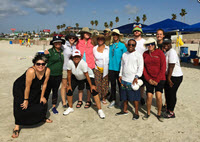
Larissa describes science as her “first love” and can’t recall a time when she wasn’t involved with science in some way. Growing up in a seaside town, she created strong ties to the beach. The more she learned about beach ecosystems, the more her curiosity about environmental science deepened. Later, she completed undergraduate degrees in civil and environmental engineering and a master’s degree in environmental engineering at the University of Miami. While applying to doctoral programs, Larissa received an email from one of her previous professors, Dr. Helena Solo-Gabriele, advertising a graduate research opportunity with her lab. Larissa applied and joined Dr. Solo-Gabriele’s team investigating children’s health risks to oil spill compounds in beach environments.
“I am deeply interested in exploring the integrated relationship between the environment and human health, so our team’s research was a perfect match to my interests,” said Larissa. “Children’s environmental health is a topic close to my heart, as children are more vulnerable to environmental health issues.”
Her Work
Following Deepwater Horizon, responders and researchers collected tens of thousands of seawater, sediment, and atmospheric samples. The first phase of Larissa’s research was to sort this historical data. Using the General NOAA Operational Modeling Environment (GNOME)’s predicted timing of oil spill impacts, she categorized the data by time and space: impacted sites prior to oil impact, impacted sites after oil impact, and unimpacted sites. She also assisted efforts led by Dr. Alesia Ferguson to video record (with guardian permission) children’s beach play activities and patterns to characterize children’s interactions with sand and other potential sources of oil contamination. She is currently developing an algorithm that will utilize a fate and transport model’s outputs for future predictions of concentrations of individual toxic oil compounds that might reach nearshore waters and sand.
The second phase of Larissa’s research focuses on analyzing oil compounds associated with Deepwater Horizon that were identified as toxic. Using an oil spill fate and transport model, she tracks how long it will take each compound to reach the beach environment. Then, she incorporates existing data about the compound’s physical and chemical properties to predict how much it should be degraded when it reaches the nearshore environment. “Some of the oil compounds won’t get there at all because they will be completely degraded or become airborne before arrival,” explained Larissa. “But, most of them will, and we need to know how much and what health risks are associated with those concentrations.” She uses her results to generate concentration-frequency distributions, a type of histogram that represents how often a measured concentration falls within a certain range in sand/marsh sediment, water, and tar. She then compares concentration ratios of the different compounds to the original source oil to identify changes in the oil’s overall composition by the time it reaches the beach environment.
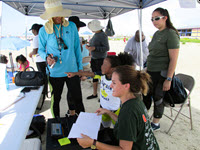
The third phase of Larissa’s research uses atmospheric remote sensing to estimate the impacts of toxic airborne compounds associated with Deepwater Horizon on beach environments. She assists Dr. Naresh Kumar to assess changes in remotely-sensed parameters immediately before and after the spill, collocated with meteorological conditions and adjusted using region specific regression. Using this approach, researchers can develop beach-specific concentrations of airborne compounds for future oil spill exposure studies.
Larissa’s research will contribute to an assessment platform providing health risk information for children swimming or playing at oil-impacted beaches. “Children’s behavioral patterns make them more vulnerable than adults, and they have more-intimate contact with the sand due to play activities such as burying themselves in the sand,” said Larissa. “Our risk assessment platform aims to help improve estimations about children’s exposures and risks to toxic oil compounds and inform decision makers and first responders about toxic compound concentrations when an oil slick approaches the nearshore environment.”
Her Learning
Working with Dr. Solo-Gabriele taught Larissa that the rigorous scientific process can also be an exciting, creative, and collaborative process. One of Larissa’s favorite memories was assisting with fieldwork that quantified children’s beach play activities. The team worked from early morning to late evening collecting data on over 100 children playing at four beaches in Florida and Texas. “The whole BEACHES team came together, and the PIs worked hard side-by-side with the students,” said Larissa. “It was collaboration at its best and gave me the opportunity to learn about the work that Co-PIs Dr. Alicia Ferguson and Dr. Kristi Mena are leading.”
Larissa’s journey has shown her that exploring different fields and seeking guidance from mentors are important goals for students considering a scientific career. “Students’ motivations are as varied as they are as individuals,” she said. “A good way to start is to take initiative and volunteer for a project that matches your interests. Many professors like giving advice. Don’t be afraid to seek out mentors who can help you understand where to take that first step.”
After graduating, Larissa wants to continue interdisciplinary research investigating environmental contaminants and human health.
Praise for Larissa
Dr. Solo-Gabriele said that Larissa was at the top of her list when recruiting graduate students for her GoMRI project. She described Larissa as having “an engineering mind,” praising her methodical approach to research and detailed-oriented personality. She explained that Larissa’s laboratory experience gave her an advantage when analyzing the complex chemical composition of oil in air, water, and sediments. “She understands the details of the analytical techniques and the difficulties that may occur when trying to compare the results from different laboratories,” said Dr. Solo-Gabriele. “Larissa has submitted a peer-reviewed journal article [based on her research] that provides insight to the natural background concentrations of oil spill compounds, which is useful for identifying the excess risks associated with oil spill impacts along coastal regions.”
The GoMRI community embraces bright and dedicated students like Larissa Montas and their important contributions. The GoMRI Scholars Program recognizes graduate students whose work focuses on GoMRI-funded projects and builds community for the next generation of ocean science professionals.
By Stephanie Ellis and Nilde Maggie Dannreuther. Contact sellis@ngi.msstate.edu for questions or comments.
************
The Gulf of Mexico Research Initiative (GoMRI) is a 10-year independent research program established to study the effect, and the potential associated impact, of hydrocarbon releases on the environment and public health, as well as to develop improved spill mitigation, oil detection, characterization and remediation technologies. An independent and academic 20-member Research Board makes the funding and research direction decisions to ensure the intellectual quality, effectiveness and academic independence of the GoMRI research. All research data, findings and publications will be made publicly available. The program was established through a $500 million financial commitment from BP. For more information, visit http://gulfresearchinitiative.org/.
© Copyright 2010-2019 Gulf of Mexico Research Initiative (GoMRI) – All Rights Reserved. Redistribution is encouraged with acknowledgement to the Gulf of Mexico Research Initiative (GoMRI). Please credit images and/or videos as done in each article. Questions? Contact web-content editor Nilde “Maggie” Dannreuther, Northern Gulf Institute, Mississippi State University (maggied@ngi.msstate.edu).
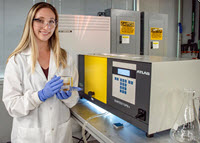
When an oil slick is exposed to sunlight, photo-oxidation processes break the oil down and incorporate oxygen into the petroleum molecules. When the incorporated oxygen reaches a certain amount, the petroleum can dissolve in water and potentially affect marine organisms and ecosystems. Sydney Niles is investigating how photo-oxidation alters the oil’s molecular composition and if that process forms toxic water-soluble oil compounds that may affect environmental and public health. Her research may help the response community better understand oil’s molecular-level effects on ecosystems and communities and inform future clean-up and restoration efforts.
Sydney is a Ph.D. student with the Florida State University Department of Chemistry and Biochemistry and a GoMRI Scholar with the project The State-of-the-Art Unraveling of the Biotic and Abiotic Chemical Evolution of Macondo Oil: 2010-2018.
Her Path
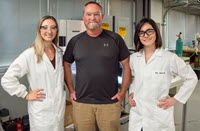
As a child, Sydney was curious about how things work and enjoyed finding the answers in her science classes. She discovered a love for chemistry in high school, when she learned that chemical reactions can explain the molecular-level activities behind phenomena such as color changes in oxidized metals. As an undergraduate chemistry major at the University of Michigan, she gained lab experience while working on a Parkinson’s study and later in an environmental research lab focusing on analytical chemistry. She was amazed that scientists could use electron microscopes and analytical techniques to clearly observe micron-size aerosol particles and determine which elements were present. The experience sparked her desire to use analytical chemistry to benefit the environment and public health.
Sydney joined Dr. Alan Marshall’s research group at Florida State University as a graduate student hoping to work with the National High Magnetic Field Laboratory’s mass spectrometers (instruments that can measure the mass of individual compounds). She began working more closely with Dr. Ryan Rodgers after deciding to focus her research on petroleum applications.

“Growing up in Michigan, I loved being in nature and taking summer trips to the Great Lakes, where we have beautiful beaches and clean, clear water. I couldn’t imagine an event like Deepwater Horizon happening to the ecosystems I enjoyed back home,” said Sydney. “I was initially wary about working with petroleum, as I have always been passionate about wildlife and taking care of the planet. However, I realized Dr. Rodger’s group was also focused on environmental applications involving petroleum, and I became passionate about using the tools at my disposal to contribute to GoMRI’s research goals.”
Her Work
Sydney mimics in situ oil photo-oxidation in the lab using a solar simulator and oil collected directly from the Macondo well during spill response. She analyzes the oil before and after irradiation using Fourier-transform ion cyclotron resonance mass spectrometry (FT-ICR MS). This process describes oil samples on a molecular level and allows her to compare oil compounds present before and after sunlight exposure. Since molecular composition is closely tied to oil’s tendency to aggregate and form emulsions and deposits, identifying the compounds present after irradiation can help determine how petroleum will behave in the environment. She conducts similar analyses on oil sheens and tar balls collected from oiled beaches and compares them to lab-irradiated samples. She found that lab-irradiated samples strongly resemble those collected from oiled beaches but do not resemble lab-generated samples created using biodegradation. This suggests that sunlight created oxygenated compounds identified in field samples rather than processes associated with oil-degrading bacteria.
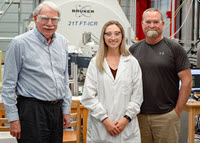
So far, Sydney has observed that photo-oxidation forms oxygenated oil- and water-soluble compounds that are not present in the samples prior to irradiation. Some of the oil-soluble compounds act like surfactants that cause oil slicks to swell with seawater and form strong, mousse-like emulsions. The emulsions’ oil- and water-soluble components are difficult to separate, which can impede clean-up efforts. “Typically, the densities of oil and water are different enough that you can easily scoop up an oil layer without disrupting the water layer,” she explained. “Separating the oil and water is much more difficult if an emulsion has formed (imagine shaking up oil and vinegar dressing and then trying to isolate the two layers). These mousses can be several feet thick, and the incorporation of water makes them heavier and increases the volume of material that needs to be cleaned up.” While both oil- and water-soluble compounds contain potentially toxic hydrocarbons, water-soluble compounds are of specific interest to Sydney’s research because they travel more freely throughout marine ecosystems.
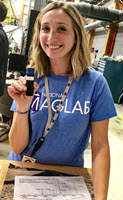
Sydney will test the toxicity of water-soluble compounds formed through the irradiation process using microtox bioassays, adding bioluminescent bacteria to a water sample containing the irradiated compounds and measuring luminescence at given time points. Luminescence will decrease when bacteria are killed by toxic compounds, allowing her to correlate luminescence with toxicity in the sample. “Petroleum hydrocarbons have known toxicity, and we are curious to see if they are released into the environment as water-soluble compounds after photo-oxidation,” she explained. “Understanding how different weathering processes contribute to the oil’s chemical and physical changes in the environment is the best way to plan better clean-up strategies for future spills.”
Her Learning
Sydney’s experiences conducting GoMRI research often reminded her of why she came to love chemistry. She recalled an experiment that placed dark brown oil into a solar simulator for several days, transforming it into a light brown fluffy emulsion with a peanut butter consistency. She viewed the samples in the FT-ICR and saw dramatic changes in the oil molecules after photo-oxidation. “These results were just as fascinating to me as my high school chemistry class, where a reaction represents how molecules change and a physical change is also observed,” she said.
Her Future
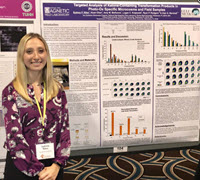
Sydney hopes to continue researching petroleum and the environment with an industry or at a national lab. She suggests that students considering a scientific career should participate in undergraduate research before pursuing graduate school, “Research is very different than classes, so make sure you like doing research before applying to graduate school.” She explains that finding a research project that sparks true passion in you is the best motivator for a science student. “If you are doing something you feel is important for society or the environment, you will be much more motivated in the lab,” she said. “Dr. Rodgers is very passionate about how our research can impact human health, animal health, and the environment, which helped me to see the bigger picture every step of the way.”
Praise for Sydney
Dr. Marshall recalled that Sydney immersed herself in the research from the moment she arrived at Florida State University. He describes her as a multi-tasker who often works on several projects at once, including mastering the National High Magnetic Field Laboratory’s custom-built FT-ICR MS. Her research has led to 14 poster and oral presentations at major scientific conferences, and her Ph.D. dissertation promises to yield multiple journal articles. “Her first paper, soon to appear in Environmental Science & Technology, provides definitive evidence that ketones and aldehydes generated in weathered petroleum essentially derive completely from photo-oxidation, not biodegradation,” he said.
The GoMRI community embraces bright and dedicated students like Sydney Niles and their important contributions. The GoMRI Scholars Program recognizes graduate students whose work focuses on GoMRI-funded projects and builds community for the next generation of ocean science professionals.
By Stephanie Ellis and Nilde Maggie Dannreuther. Contact sellis@ngi.msstate.edu for questions or comments.
************
The Gulf of Mexico Research Initiative (GoMRI) is a 10-year independent research program established to study the effect, and the potential associated impact, of hydrocarbon releases on the environment and public health, as well as to develop improved spill mitigation, oil detection, characterization and remediation technologies. An independent and academic 20-member Research Board makes the funding and research direction decisions to ensure the intellectual quality, effectiveness and academic independence of the GoMRI research. All research data, findings and publications will be made publicly available. The program was established through a $500 million financial commitment from BP. For more information, visit https://gulfresearchinitiative.org/.
© Copyright 2010-2019 Gulf of Mexico Research Initiative (GoMRI) – All Rights Reserved. Redistribution is encouraged with acknowledgement to the Gulf of Mexico Research Initiative (GoMRI). Please credit images and/or videos as done in each article. Questions? Contact web-content editor Nilde “Maggie” Dannreuther, Northern Gulf Institute, Mississippi State University (maggied@ngi.msstate.edu).
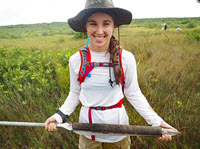
Petroleum hydrocarbons buried in sandy beaches are protected from tides and UV light and, thus, may persist longer in the environment than oil on the beach surface. As a graduate student, Ioana Bociu’s research focused on determining the degradation rates for large sediment-oil clusters buried in Florida beaches following Deepwater Horizon. Her findings will help inform environmental managers about the persistence of buried oil in the environment, which could affect recovery after an oil spill.
Ioana, who recently completed her graduate studies, was a master’s student with the Florida State University Department of Earth, Ocean, and Atmospheric Science. During that time, she was a GoMRI Scholar with the project A Systems Approach to Improve Predictions of Biodegradation and Ecosystem Recovery in Coastal Marine Sediments Impacted by Oil Spill.
Her Path
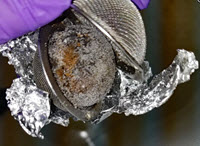
Growing up in Romania and then the United States, Ioana was curious about and interested in nature and conservation. She began her undergraduate studies at Florida State University with a double-major in International Affairs and Japanese, but felt drawn to environmental issues. She switched her major to Environmental Science and began taking environmental science, geology, and oceanography classes. Her first class with Dr. Jeffrey Chanton got her interested in the carbon cycle and the need for filling gaps in ocean science research. Later on, a class with Dr. Ian MacDonald introduced her to oil biogeochemistry and Ph.D. candidate Brian Wells. She told Wells she wanted to do volunteer laboratory work, and he invited her to assist with his research investigating oil biodegradation in the Gulf of Mexico under Dr. Markus Huettel.
After completing her undergraduate degrees, Ioana conducted field work at the Florida Fish and Wildlife Research Institute for two years, which solidified her passion for carbon cycle research and sparked her desire to pursue graduate school. “When I had the chance of returning to Dr. Huettel’s lab, I was very enthusiastic to begin the GoMRI project as a master’s student,” she said. “I enjoy doing environmental research and learning about natural processes and mechanisms. My drive comes from wanting to understand what is happening in the environment after a long-term disturbance like the Deepwater Horizon oil blowout.”
Her Work
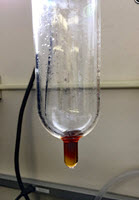
Shortly after the oil spill, the Huettel team conducted an experiment using 100 round metal tea infusers filled with homogenized, weathered oil-sand mixtures (agglomerates) collected from Florida beaches. They buried the agglomerates in Florida beaches in sets of ten in sand at 10-50 cm depth at 10-cm intervals, retrieved the agglomerates at pre-determined intervals over 3 years, and then froze the samples until analysis.
Ioana’s team analyzed the agglomerates for weight loss and change in diameter, which could indicate microbial biodegradation of the oil. A noticeable change in the agglomerates’ color over time prompted Ioana and her team to conduct a color and fluorescence analysis. They applied an elemental analyzer coupled to an isotope ratio mass spectrometer to evaluate temporal changes in carbon content and carbon type (stable isotopes) in the agglomerates. Using a gas chromatograph coupled to a gas mass spectrometer, the team assessed temporal changes in the samples’ petroleum hydrocarbon compositions. Because environmental samples can contain thousands of compounds, Ioana and her team focused only on hydrocarbons considered harmful to humans by the Environmental Protection Agency and the International Agency of Research on Cancer. In total, her team evaluated 30 saturated hydrocarbons and 33 polycyclic aromatic hydrocarbons (PAHs).
Based on these analyses, Ioana estimated that the golf-ball-sized aggregates buried in beach sands would degrade within 3 decades. She further observed that the half-lives (the time required for a quantity to reduce to half its initial value) of saturated hydrocarbons varied between 100 – 568 days and correlated to carbon chain length, with longer (heavier) carbon chains degrading more slowly than shorter carbon chains. The half-lives of PAHs varied between 94 – 836 days, depending on the compound. In comparison, reference agglomerates kept in the dark for approximately 7.4 years without sediment exposure degraded three-times more slowly than agglomerates buried in situ.
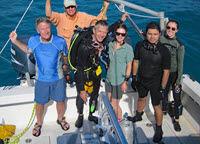
“The most critical part of our study is understanding the rate of degradation of buried oiled material, as most studies address oil degradation only in surface sediments. Buried material can persist for longer periods,” explained Ioana. “The more we can learn about what is going on in the environment, the better prepared we can be in the future. A significant part of my motivation comes from wanting to help resolve future issues by providing useful information to the greater public.”
Her Learning
Working in Huettel’s lab had a significant impact on Ioana’s growth as a scientist. Analyzing sediment-oil agglomerates involved a sophisticated extraction and measuring process that required a team effort to complete. This teamwork taught Ioana how to effectively interact with other researchers. She also gained leadership experience while teaching undergraduate students involved with the oil extraction process about the procedures and problem-solving techniques. Ioana’s conversations with Dr. Huettel had a great impact on her growth as a researcher, “Dr. Huettel was very patient with me, as there were quite a few times I walked into his office with a nervous laugh, struggling with something. I realized that verbalizing what I was thinking helped a lot in solving the issues I had. From brief conversations with him, I was able to proceed with the task at hand.”
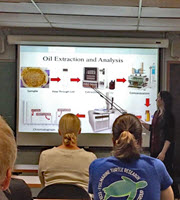
Presenting her research at the 2018 Gulf of Mexico Oil Spill and Ecosystem Science conference was an especially memorable experience for Ioana. Although she initially felt intimidated by the many experienced researchers present, she found that the conference community was extremely supportive and provided helpful feedback, leaving her feeling revitalized and ready to tackle the next steps of her master’s work.
Her Future
Ioana completed her master’s degree in spring 2018 and is searching for a government agency position conducting research on coastal or carbon cycle topics, broadening her experience and becoming a well-rounded scientist. She said that science students should consider the direction they want to go and the sacrifices they are willing to make at every step of their career. “There will be monotonous days when you have to redo samples or go through large batches of data, but in my opinion the reward of having data that can tell us something we didn’t know about Earth really pays off,” said Ioana. “As with everything in life, there are pros and cons – you just have to learn to find happiness in your choices.”
Praise for Ioana
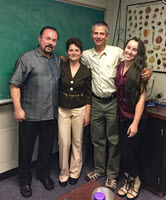
Dr. Huettel praised Ioana’s enthusiasm and motivation, stating that her attitude had an immediate and positive affect on everyone in his lab. He said that Ioana optimized the hydrocarbon extraction line beyond factory-specified efficiency and became the lab’s expert in running the GC-MS. He explained that she kept a cool head throughout the group’s research and impressed him with her ability to evaluate the complex data sets produced by the GC-MS, despite frequent software crashes. “I guess she could eliminate any research frustration as she honed her aerialist skills while practicing and performing,” he joked.
Huettel noted that when the lab brought on undergraduate students, Ioana became their dedicated supervisor. “It was great to see how, even at this early stage of her career, she managed her own lab group, making sure that high-quality standards were maintained, work was completed on time, and that everybody always stayed well-hydrated,” he said. “She is a born leader, fun to work with, and a role model for her peers.”
The GoMRI community embraces bright and dedicated students like Ioana Bociu and their important contributions. The GoMRI Scholars Program recognizes graduate students whose work focuses on GoMRI-funded projects and builds community for the next generation of ocean science professionals.
By Stephanie Ellis and Nilde Maggie Dannreuther. Contact sellis@ngi.msstate.edu for questions or comments.
************
The Gulf of Mexico Research Initiative (GoMRI) is a 10-year independent research program established to study the effect, and the potential associated impact, of hydrocarbon releases on the environment and public health, as well as to develop improved spill mitigation, oil detection, characterization and remediation technologies. An independent and academic 20-member Research Board makes the funding and research direction decisions to ensure the intellectual quality, effectiveness and academic independence of the GoMRI research. All research data, findings and publications will be made publicly available. The program was established through a $500 million financial commitment from BP. For more information, visit https://gulfresearchinitiative.org/.
© Copyright 2010-2019 Gulf of Mexico Research Initiative (GoMRI) – All Rights Reserved. Redistribution is encouraged with acknowledgement to the Gulf of Mexico Research Initiative (GoMRI). Please credit images and/or videos as done in each article. Questions? Contact web-content editor Nilde “Maggie” Dannreuther, Northern Gulf Institute, Mississippi State University (maggied@ngi.msstate.edu).
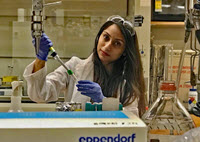
Petroleum hydrocarbons released by oil spills can accumulate on beaches and in nearshore sediments, potentially creating health risks for humans and coastal organisms. However, the highly variable conditions of beach environments make it difficult to determine the long-term behavior and fate of hydrocarbons in sands and sediment. Smruthi Karthikeyan combines bioinformatics and oil degradation data to examine microbial responses to oil in beach environments and identify populations that act as bioindicators of oil degradation and toxicity. Documenting microbial indicators and producing oil degradation models for environmental managers can help with future oil spill response plans for coastal zones.
Smruthi is a Ph.D. student with the Georgia Institute of Technology’s School of Civil and Environmental Engineering and a GoMRI Scholar with the project A Systems Approach to Improve Predictions of Biodegradation and Ecosystem Recovery in Coastal Marine Sediments Impacted by Oil Spill.
Her Path

Smruthi grew up in Chennai, India, near one of the largest beaches in the world, which sparked her interest in environmental health. Later, she completed an undergraduate chemical engineering program at Anna University because of its practical applications. She then transitioned to Columbia University for her master’s environmental engineering studies, which she considers an ideal interdisciplinary field that unites science and technology. “Being in the environmental engineering field gives me a lot of opportunities to view the environment from different perspectives,” she said.
Smruthi’s Ph.D. advisor Dr. Kostas Konstantinidis introduced her to the microbial world during one of his classes. She was intrigued about using bioinformatics to elicit information from such tiny creatures and was curious about the microbial role in environmental pollutant biodegradation. Konstantinidis received GoMRI funding in 2016 to research how microbes respond to oiling and identify indicator species for oil degradation and toxicity in beach sands. Accepting a position on his team made Smruthi excited about combining her love of environmental preservation with microbial genomics.
Her Work
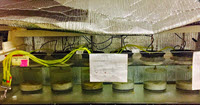
Smruthi conducts laboratory mesocosm experiments that mimic the in situ conditions found in the beach environment. She incubates Pensacola beach sand collected at different times during the Deepwater Horizon incident in six acrylic chambers (three with oiled sand and three with pristine sand) and replicates the tidal cycle by periodically adding and removing water overlying the sand. While sensors monitor pH, oxygen, nutrient, and temperature levels inside the chambers, she collects sand samples at designated time intervals and analyzes the microbial community’s DNA and RNA.
“Thanks to recent developments in cultivation-independent and next-generation sequencing methods, we are able to see microbial communities at a much higher resolution than ever before and identify their activities and nutrient limitations,” said Smruthi. “We can answer not only ‘Who is there?’ but also ‘What are they doing?’ from less than a gram of sand sample.”
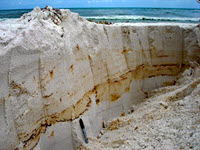
Smruthi’s analyses identify microbial populations with reduced abundance after oil exposure and observe if they return after oil is completely removed. Populations that do not return could warrant further investigation to assess how long it may take an ecosystem to recover after oiling. Her analyses also examine the gene content of individual microbial populations and compare them to hydrocarbons used in the experiment to determine which oil-degrading genes the microbes possess. A microbe that is more abundant after oil exposure may be a viable bioindicator of oil presence and biodegradation processes. Smruthi hopes that comparing her microbial data to the in situ sensor data can help develop an integrated conceptual model that allows predictions of pathways and oil degradation rates needed for future forecasts of recovery pathways.
Smruthi’s analyses have revealed a previously undiscovered microbial genus that was below detection in clean sands but rapidly increased to 30% of the total microbial community in oiled sands. According to publicly available databases, the species appears consistently in oil-contaminated sediments worldwide, particularly as a responder to other major oil spills, while being notably absent in unoiled environments. The microbe is metabolically versatile and can feast on oil and get the nitrogen it needs from the atmosphere, eliminating the need to add potentially harmful fertilizers that encourage microbial oil degradation. “It appears that this microbe belongs to a new genus of keystone oil degraders that has gone unnoticed so far and thus could represent a new model organism for oil bioremediation efforts,” said Smruthi. “We proposed to name this new bacterial genus “Macondimonas,” as we recovered it from the Macondo oil spill.”
Her Learning
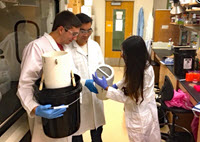
Smruthi’s experiences conducting GoMRI research opened her eyes to many different perspectives of oil spill research. Working with her advisor and their project’s principal investigator Dr. Markus Huettel helped her see the multifaceted aspects of her research, while interacting with scientists from different disciplines broadened her scientific perspective. “As someone who did not have a background in computational biology and marine ecology initially, this GoMRI grant has greatly helped my venture into this new and fascinating area,” she said. “It showed me that there’s a whole new realm out there filled with these microscopic marvels while at the same time integrating my engineering background.”
Her Future
Smruthi hopes to become a professor after completing her Ph.D. She encourages students considering a career in science and technology by telling them, “It is a rewarding and satisfying experience to actually see that your work can someday help the environment and society in whatever little way it can.”
Praise for Smruthi
Konstantinidis said that Smruthi is a hard worker with strong analytical abilities and a tremendous capacity and desire to learn new things. Her contributions helped his team explore new research ideas that resulted in important discoveries, such as the new oil-degrading bacteria. “[Our work with Smruthi] happened due to a bit of good luck,” he said. “When the advisor that Smruthi was working with initially decided to retire, I talked to Smruthi about the GoMRI project, and she got really excited and wanted to join our research team. It was good luck for all of us, I think!”
The GoMRI community embraces bright and dedicated students like Smruthi Karthikeyan and their important contributions. The GoMRI Scholars Program recognizes graduate students whose work focuses on GoMRI-funded projects and builds community for the next generation of ocean science professionals.
************
The Gulf of Mexico Research Initiative (GoMRI) is a 10-year independent research program established to study the effect, and the potential associated impact, of hydrocarbon releases on the environment and public health, as well as to develop improved spill mitigation, oil detection, characterization and remediation technologies. An independent and academic 20-member Research Board makes the funding and research direction decisions to ensure the intellectual quality, effectiveness and academic independence of the GoMRI research. All research data, findings and publications will be made publicly available. The program was established through a $500 million financial commitment from BP. For more information, visit https://gulfresearchinitiative.org/.
© Copyright 2010-2018 Gulf of Mexico Research Initiative (GoMRI) – All Rights Reserved. Redistribution is encouraged with acknowledgement to the Gulf of Mexico Research Initiative (GoMRI). Please credit images and/or videos as done in each article. Questions? Contact web-content editor Nilde “Maggie” Dannreuther, Northern Gulf Institute, Mississippi State University (maggied@ngi.msstate.edu).
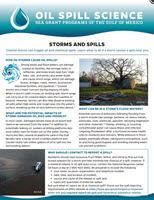
The Sea Grant Oil Spill Outreach Team released a Fact Sheet that uses easy-to-understand graphics and descriptions about how some oil accumulated at shorelines, on the ocean’s surface, in an underwater plume, and on the seafloor.
Where did the oil go? A Deepwater Horizon fact sheet provides a public-friendly resource for all who are interested in a healthy marine environment. The publication highlights the important points made in the more detailed eight-page bulletin Deepwater Horizon: Where did the oil go?
Oil also provided a food source for certain microbes who increased their numbers where oil was present to ingest it. Learn more about the role that microbes play in oil fate: Microbes and oil: What’s the connection?
The Sea Grant Oil Spill Outreach Team synthesizes peer-reviewed science for a broad range of general audiences, particularly those who live and work across the Gulf Coast. Sea Grant offers oil-spill related public seminars across the United States.
Information about upcoming Sea Grant science seminars and recently-held events is available here. To receive email updates about seminars, publications, and the outreach team, click here.
************
GoMRI and the Sea Grant programs of the Gulf of Mexico (Florida, Mississippi-Alabama, Louisiana, and Texas) have partnered to create an oil spill science outreach program.
The Gulf of Mexico Research Initiative (GoMRI) is a 10-year independent research program established to study the effect, and the potential associated impact, of hydrocarbon releases on the environment and public health, as well as to develop improved spill mitigation, oil detection, characterization and remediation technologies. An independent and academic 20-member Research Board makes the funding and research direction decisions to ensure the intellectual quality, effectiveness and academic independence of the GoMRI research. All research data, findings and publications will be made publicly available. The program was established through a $500 million financial commitment from BP. For more information, visit https://gulfresearchinitiative.org/.
© Copyright 2010- 2018 Gulf of Mexico Research Initiative (GoMRI) – All Rights Reserved. Redistribution is encouraged with acknowledgement to the Gulf of Mexico Research Initiative (GoMRI). Please credit images and/or videos as done in each article. Questions? Contact web-content editor Nilde “Maggie” Dannreuther, Northern Gulf Institute, Mississippi State University (maggied@ngi.msstate.edu).
In April 2010, the Deepwater Horizon (DWH) oil spill, the largest offshore spill in U.S. history, occurred in the Gulf of Mexico. Emergency response personnel, natural resource managers, non-profit organization staff, scientists, volunteers, and many others worked together to rescue sea turtles. Sea turtles are some of the world’s most well-known endangered and threatened animals. So far, what have we learned about the impact DWH had on sea turtles in the Gulf?
THE BASICS OF THE SEA TURTLE LIFE CYCLE
Sea turtles are long-lived, air-breathing reptiles that spend most of their lives in the sea. They are highly migratory and depend on several habitats across large geographic areas throughout their life cycle. As hatchlings, sea turtles emerge from eggs located in nests on sandy beaches. Hatchlings crawl from their nests to the nearest coastal waters and swim out into the open ocean. These young turtles spend the next phase of their lives in and around convergence zones, or areas where open ocean currents come together. Here they feed and grow. As juveniles, they spend much of their time at or near the ocean surface. Click the link below for more…
This work was made possible in part by a grant from The Gulf of Mexico Research Initiative, and in part by the Sea Grant programs of Texas, Louisiana, Florida and Mississippi-Alabama. The statements, findings, conclusions and recommendations do not necessarily reflect the views of these organizations.
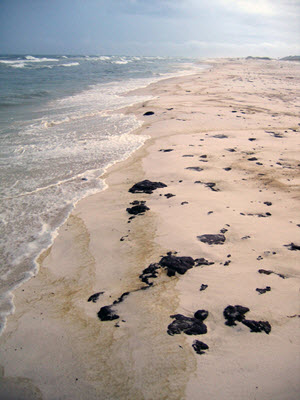
(Click to enlarge) Partially buried oil at Pensacola Beach, Florida, showing oil deposited in intertidal (partially submerged) and supratidal (exposed) sands. Depending on the location of the oil burial, oil-degrading microbes are exposed to very different environmental settings ranging from permanently submerged to permanently dry. The location of the buried oil also affects the oil’s exposure to oxygen, nutrients, and heat and thus impacts the rates of microbial degradation. (Photo by Markus Huettel)
Spilled oil buried in nearshore sediment can persist for many years and act as a long-term source of episodic hydrocarbon contamination in the environment.
Although we have a basic understanding of how fast crude oil degrades in soils, we still do not fully understand what influences the degradation process or the microbial community responsible for oil decomposition in the seabed.
The Gulf of Mexico Research Initiative awarded Dr. Markus Huettel a grant to investigate buried oil’s microbial degradation in coastal environments and create a model that can help predict oil degradation rates and pathways for future spills. His team will combine cutting-edge microbiological and geochemical techniques in the field with targeted laboratory experiments to uncover how microbial communities degrade buried oil under varying environmental conditions.
Microbial oil degradation is most effective in oxygen-rich conditions. Huettel’s team will incubate sediment cores in mesocosms that can simulate oil transport caused by tides, water currents, and air flows. They will collect time-series molecular data to characterize interactions between the environment and microbial communities and will use hydrocarbon composition data to determine the degradation rates of specific hydrocarbon classes. The incubation treatments will vary in oxygen concentration, temperature, and level of nutrients to test how different conditions affect microbial oil degradation.
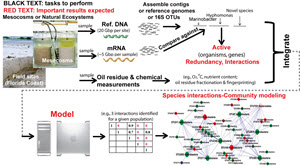
Click to enlarge) A conceptual overview of the modeling analysis of shore sand microbial communities. (Figure by Kostas Konstantinidis)
The team will use their findings to create a model that links microbial sedimentary oil degradation to key environmental variables. The goal is to present this model in a format that managers and decision makers can use when planning responses to future oil spills. Huettel explains, “This project aims to open the ‘black box’ surrounding the mechanisms of buried oil degradation and generate a tool that can forecast oil degradation pathways and the potential environmental and health risks associated with petroleum hydrocarbons still persisting in the coastal environment.”
The project’s investigators are Markus Huettel of Florida State University and Kostas Konstantinidis and Joel Kostka of the Georgia Institute of Technology. Their project is A Systems Approach to Improve Predictions of Biodegradation and Ecosystem Recovery in Coastal Marine Sediments Impacted by Oil Spills.
************
The Gulf of Mexico Research Initiative (GoMRI) is a 10-year independent research program established to study the effect, and the potential associated impact, of hydrocarbon releases on the environment and public health, as well as to develop improved spill mitigation, oil detection, characterization and remediation technologies. An independent and academic 20-member Research Board makes the funding and research direction decisions to ensure the intellectual quality, effectiveness and academic independence of the GoMRI research. All research data, findings and publications will be made publicly available. The program was established through a $500 million financial commitment from BP. For more information, visit http://gulfresearchinitiative.org/.
The Sea Grant Oil Spill Outreach team released two new brochures that discuss Deepwater Horizon and beached oil.
 Top 5 Frequently Asked Questions about the Deepwater Horizon Oil Spill: Five years after the incident, tourists to the Gulf of Mexico still have questions about the oil spill. This publication addresses how the oil was cleaned up, where the oil moved in the environment, and the ecological and health impacts of the spill.
Top 5 Frequently Asked Questions about the Deepwater Horizon Oil Spill: Five years after the incident, tourists to the Gulf of Mexico still have questions about the oil spill. This publication addresses how the oil was cleaned up, where the oil moved in the environment, and the ecological and health impacts of the spill.
Navigating Shifting Sands: Oil on our Beaches : This publication highlights how oil from the Deepwater Horizon oil spill was buried, how it moves around, and how scientists track oil.
: This publication highlights how oil from the Deepwater Horizon oil spill was buried, how it moves around, and how scientists track oil.
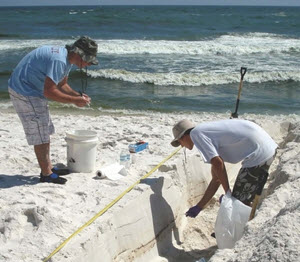
Jonathan Delgardio and Will A. Overholt (Georgia Institute of Technology) collect samples from a Pensacola Beach sand trench with oil layers. (Photo by Markus Huettel)
Genomics is a powerful method to track things that humans cannot see. Months and years after the Deepwater Horizon oil spill, many people wondered where the oil went or where it might be lingering or what it may affect after it was no longer visible. Scientists are using genomic techniques such as DNA sequencing to help answer some of these questions.
The Smithsonian posted an article featuring scientists Joel Kostka, Jack Gilbert, and David Portnoy. Kostka’s work focuses on using genetic markers of microbes to determine whether or not shorelines have been affected by the oil spill. Gilbert’s work focused on identifying microbes who feed on carbon as a way to determine if oil is being degraded in environments such as sediment. Portnoy’s work focuses on detecting possible long-term impacts on fish that live in waters exposed to the oil spill.
Read the Ocean Portal article to learn how genomics help us understand oil spill impacts.
For more information about oil spill research that employs genomics, read:
************
GoMRI and the Smithsonian have a partnership to enhance oil spill science content on the Ocean Portal website.
The Gulf of Mexico Research Initiative (GoMRI) is a 10-year independent research program established to study the effect, and the potential associated impact, of hydrocarbon releases on the environment and public health, as well as to develop improved spill mitigation, oil detection, characterization and remediation technologies. An independent and academic 20-member Research Board makes the funding and research direction decisions to ensure the intellectual quality, effectiveness and academic independence of the GoMRI research. All research data, findings and publications will be made publicly available. The program was established through a $500 million financial commitment from BP. For more information, visit http://gulfresearchinitiative.org/.
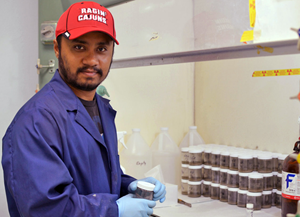
Nihar conducts a 14C-radiolabeled naphthalene assay in a radioactive laboratory to determine naphthalene degradation rate using sediments after each greenhouse microcosm experiment. (Photo credit: Suchandra Hazra)
Nihar Deb Adhikary uses his veterinary training and microbiology research to better understand the connections between oil fate, microbial degradation, and sediment-dwelling organisms such as shrimp and clams.
“Oil in coastal sediment can significantly impact the animals that live there,” he said. “I think it will be amazing if we can show that these benthic organisms help enhance oil degradation.” Nihar is an environmental and evolutionary biology Ph.D. student at the University of Louisiana at Lafayette and a GoMRI Scholar with the project The Effect of Sediment Bioturbators on the Biological Degradation of Petroleum in Coastal Ecosystems. He explains how a background in veterinary medicine led to studying oil-degrading microbes.
His Path
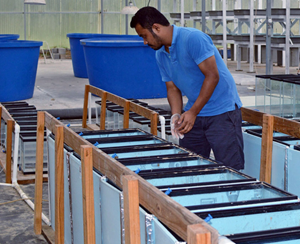
Nihar samples sediment and water from microcosms in the project’s greenhouse.
(Photo credit: Suchandra Hazra)
Nihar, an animal-lover, wanted to pursue biological sciences since he was in high school. He saw a veterinary career as the perfect way to practice biology and work with animals. However, while studying veterinary medicine at West Bengal University of Animal & Fishery Sciences in Kolkata, India, he became interested in conducting molecular and microbiological research. He explained, “Working with animals made me realize there are many different ways to address animal health problems.” After completing his veterinary degree, he enrolled in a masters’ program studying bacterial biofilms at Texas State University.
While conducting biofilm research, Nihar narrowed his interests to a combination of environmental science and microbiology. His opportunity came when he met Dr. Paul Klerks and his advisor Dr. Andrei Chistoserdov through the University of Louisiana at Lafayette Ph.D. program. Nihar soon began working on their GoMRI project researching the influence of bioturbators on petroleum bioremediation. He says, “While the Deepwater Horizon oil spill was a huge environmental disaster, it also presented the perfect opportunity to conduct research in environmental microbiology.”
His Work

Nihar works at the UL Lafayette Biology Department in the Chistoserdov Lab under the hooded ventilation system to quantify PAH dioxygenase gene expression. (Photo credit: Suchandra Hazra)
Nihar’s work assesses how bioturbators – organisms such as worms, shrimp, and crabs that burrow and live in sediment – affect the fate of oil by altering the physical and chemical properties of coastal marsh and beach sediment. He and his team are focusing on ghost shrimp and stout razor clams, two organisms abundant throughout the Gulf Coast. He recreates coastal sediment conditions in a greenhouse using ten-gallon (for razor clams) and thirty-gallon (for ghost shrimp) tanks filled with water and sediment. Once the shrimp and clams have acclimated to the tanks, he introduces crude oil. After ten days, his colleagues measure oil content in the water and sediment, and Nihar assesses the composition and activity of the microbial community.
Nihar observed that ghost shrimp activity increased degradation of naphthalene, the simplest polycyclic aromatic hydrocarbon. He hypothesizes that ghost shrimp’s natural functions and movement add organic matter and allow oxygen to penetrate further into the sediment, stimulating the growth of aerobic microorganisms and thereby enhancing microbial oil degradation. Increased oil exposure due to bioturbation may also stimulate oil-degrading genes in microbes. Although he found no changes in the number of oil-degrading bacteria or the microbial community at the phylum level, he has begun analyses at the genus level and is preparing to analyze 16S rDNA libraries to better understand these findings.
His Learning
While conducting his research, Nihar enjoyed working with experts from different scientific fields. He said, “Both the laboratory work and the field sampling helped me understand the value of collaboration. Reaching out to other researchers at GoMRI meetings has broadened my insights into my own project and oil spill research as a whole.” Working with Chistoserdov and Klerks is especially exciting and encouraging for Nihar, who said that the skills and experience he has gained from them will help him with future research. “I believe I am working in a great program with great people at UL – Lafayette,” he said. “It is like a small family to me, providing me with a home away from home.”
His Future
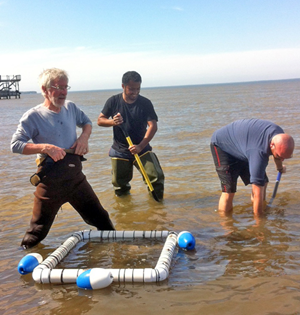
Nihar (center) collects razor clams from Choctawhatchee Bay in Defuniac Springs, Florida, with Dr. Paul Klerks (left) and fellow graduate student Alex Kascak (right). (Photo credit: Lujun Luo)
After completing his Ph.D., Nihar plans to start a career in environmental science, preferably in an environmental consulting or testing company. He is also interested in pursuing a post-doctoral position to gain more experience in his field.
Praise for Nihar
Chistoserdov described Nihar as a dedicated and inquisitive researcher whose versatility is one of his greatest strengths. He explained that Nihar feels equally at home in the field and in the laboratory. Furthermore, he is accustomed to dealing with larger animals (in their case, shrimp and clams) through his veterinary background and working with microorganisms as a trained microbiologist. Chistoserdov said these traits make Nihar an ideal researcher for their project. He explained, “Nihar’s findings were made working in close collaboration with students and faculty from our university, underscoring another of his strong points – the ability to be a productive member of a research team.”
The GoMRI community embraces bright and dedicated students like Nihar Deb Adhikary and their important contributions. The GoMRI Scholars Program recognizes graduate students whose work focuses on GoMRI-funded projects and builds community for the next generation of ocean science professionals.
Visit the Klerks Lab website to learn more about their work.
This research was made possible in part by a grant from BP/The Gulf of Mexico Research Initiative (GoMRI) to The Effect of Sediment Bioturbators on the Biological Degradation of Petroleum in Coastal Ecosystems. The GoMRI is a 10-year independent research program established to study the effect, and the potential associated impact, of hydrocarbon releases on the environment and public health, as well as to develop improved spill mitigation, oil detection, characterization and remediation technologies. An independent and academic 20-member Research Board makes the funding and research direction decisions to ensure the intellectual quality, effectiveness and academic independence of the GoMRI research. All research data, findings and publications will be made publicly available. The program was established through a $500 million financial commitment from BP. For more information, visit http://gulfresearchinitiative.org/.
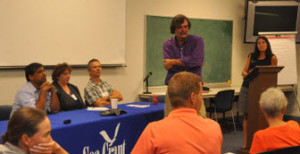 A seminar series by Sea Grant in the Gulf of Mexico (Navigating Shifting Sands: Oil on our Beaches) was held on August 5, 2015, in Pensacola, FL. Scientists shared their work to answer lingering questions about oil that washed up on Alabama and Florida beaches during the Deepwater Horizon oil spill. More than 85 participants attended this seminar in person or through webinar.
A seminar series by Sea Grant in the Gulf of Mexico (Navigating Shifting Sands: Oil on our Beaches) was held on August 5, 2015, in Pensacola, FL. Scientists shared their work to answer lingering questions about oil that washed up on Alabama and Florida beaches during the Deepwater Horizon oil spill. More than 85 participants attended this seminar in person or through webinar.
To view video and PowerPoint presentations from the 11 Speakers at the Seminar CLICK HERE
Speakers included:
Introduction to the Oil Spill Science Outreach Program
Larissa Graham is an Extension Specialist with Mississippi-Alabama Sea Grant. She facilitated the “Navigating Shifting Sands: Oil on our beaches” seminar and provided an overview of the Oil Spill Science Outreach Program.
Extent and Degree of Shoreline Oiling: Deepwater Horizon Oil Spill
Scott Zengel is a Senior Scientist with Research Planning, Inc. (RPI). Scott served as one of the NOAA shoreline assessment leads during the Deepwater Horizon oil spill, and continues to support the Natural Resource Damage Assessment (NRDA) and restoration planning efforts. He will be speaking about shoreline oiling as documented by the Shoreline Cleanup Assessment Technique (SCAT) program.
Alabama and Florida beaches and the Deepwater Horizon oil spill
Dr. Joel Hayworth is an associate professor at Auburn University. His work focuses on assessment and restoration of human-impacted natural systems. He will be talking about the broad impacts of the oil spill on Alabama and Florida nearshore and beach systems.
Sand and Oil Agglomerates in the Surf Zone: Using Science to Aid Deepwater Horizon Clean-up Efforts
Dr. Soupy Dalyander is a research oceanographer with the U.S. Geological Survey at the St. Petersburg Coastal and Marine Science Center. She studies sediment transport and geomorphological change on the beach, nearshore, and continental shelf. She will be talking about the physical dynamics of sand and oil agglomerates (essentially “sinking tar balls”), which can form when oil mixes with sediment in shallow water and are a potential source of beach re-oiling.
Physicochemical characteristics of Deepwater Horizon tar balls
Dr. Prabhakar Clement is a professor in the Environmental Engineering program at Auburn University. He has been collecting and analyzing Deepwater Horizon (DWH) oil spill tar balls for the past five years. Prabhakar is an expert in fingerprinting, identifying, and characterizing oil spill residues. He will present a field dataset to demonstrate increases in background oil contamination along Alabama’s beaches. He will also discuss the fate of some toxic polycyclic aromatic hydrocarbons trapped in DWH tar balls.
Marine tar residues: What we’ve learned from the Deepwater Horizon Spill
Dr. Patricia Sobecky is a professor and an associate provost at the University of Alabama. She is a microbiologist with expertise in marine microbiology. She’s conducted microbiology studies in the Gulf of Mexico deep sea and coastal habitats. She will be talking about the microbiology of marine tar residues (tar balls, tar mats) and their impacts on coastal ecosystems.
The fate of oil buried in Pensacola Beach sands
Dr. Markus Huettel is a professor at Florida State University. He is a coastal oceanographer and his research focuses on biogeochemical processes in marine sediments and the exchange processes between the seafloor and overlying water column. Markus will be talking about the degradation of buried Deepwater Horizon oil in Florida sandy beaches.
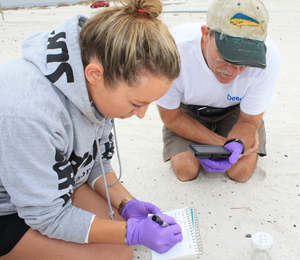
Catherine Carmichael, a research associate at WHOI, shows teacher Shawn Walker that taking detailed notes is essential when collecting data. (Photo by Danielle Groenen)
Talk about compounding interest! Put together scientists and teachers who are passionate about their work with students who are eager to help with ongoing research and watch as excitement fuels student engagement, sparks career interest, and feeds enthusiasm of all. And as a side bonus, research is conducted more efficiently in both time and cost. That’s a pretty good return on investment.
Some Florida high school students have been given an opportunity to engage in hands-on research that is as meaningful as it is fun thanks to a new initiative called Project Gulf Oil Observations (GOO). Members of the research consortium Deep Sea to Coast Connectivity in the Eastern Gulf of Mexico (Deep-C) developed Project GOO which trains teachers and students to be effective citizen scientists and puts their new-found knowledge into use during visits to Gulf beaches in search of oil patties. Deep-C studies the long-term fate and effects of petroleum hydrocarbons in the Gulf.
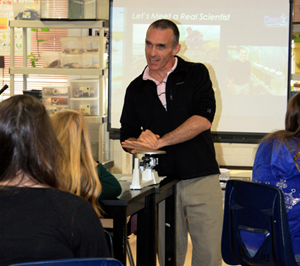
Chris Reddy deconstructs the stereotypes associated with scientists. (Photo by Danielle Groenen)
“I cannot think of better vehicles to engage students than getting their hands dirty and learning how the world, in particular the ocean, works,” said Dr. Christopher Reddy, a Woods Hole Oceanographic Institution (WHOI) marine chemist and scientist with Deep-C.
In November 2013, Deep-C representatives Amelia Vaughan and Danielle Groenen accompanied Reddy and his research associate Catherine Carmichael to West Florida High School of Advanced Technology to work with Shawn Walker, a Marine Science teacher. The Deep-C group brought action-packed lesson plans that engaged and motivated students, which Walker very much appreciated: “Their hands-on lab activities, video presentations, relevant articles, and direct instructional approaches showed significant pre-planning and organizational skills. More important, was their genuine desire to make a positive and lasting impression on the students they are working with.” The next day, the team went into the field with Walker to train him in their methods.
Calling himself “very much an outsider to the Gulf,” Reddy was pleased to find Walker not only “talented and enthusiastic,” but also possessed of an extensive knowledge of the area’s geography and coastal processes, both invaluable to the project. Explaining the significance of Walker’s local knowledge base, Reddy said, “This will play a big role when we want to ‘tell a story’ on the oiled samples that Shawn and his students collect. Being able to say ‘there are more oiled-samples here because the tides/currents are stronger’ will provide a richer context to learning how spilled oil behaves.”
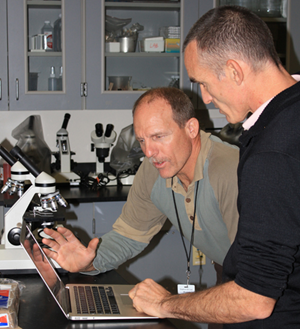
High school teacher Shawn Walker and Chris Reddy of WHOI are deep in discussion about sample analysis. (Photo by Danielle Groenen)
Walker also was very pleased, “Chris presented himself with humor to a classroom full of aspiring marine science students and, in a very informal and straightforward manner, he talked about what it takes to become a scientist, his successes and failures, and what motivated him along the way.” Walker described Chris and his presentation as a “home run” with the students because “he took off the ‘cloak of invisibility’ with his personal appearance. After all, how many research scientists have been in your classroom lately?”
In late February, Walker will take two of his classes to Gulf-front sites in the area to collect samples and mail them to the Reddy lab at WHOI for analysis. The Deep-C GOO coordinators are excited to be working with their first group of students. Over the next five months, these “GOOies” will receive on-site instruction and special training. The lesson plans and hands-on activities meet Florida’s educational standards and touch on general ocean science and oil spill research, oil degradation, how to think like a scientist, and the correct way to conduct scientific sampling.
The first phase of Project GOO was so successful that Deep-C plans to broaden it to include a school in Tallahassee at the end of March, adding Dr. Olivia Mason from Florida State University to the team for her expertise in oil analysis.
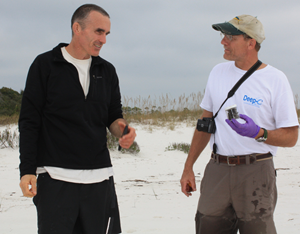
Teacher Shawn Walker and scientist Chris Reddy reflect on a hard day’s work at the beach! (Photo by Danielle Groenen)
Reddy, a specialist on following oil as it passes through the environment, has been making frequent trips to the Gulf Coast from Massachusetts to collect samples since the Deepwater Horizon oil spill in 2010. Even though the oil spill occurred more than three years ago, the process of gathering and analyzing information about the fate of the oil and dispersants will take years. The continuation of Project GOO will be a cost-effective way to get Reddy the data he needs and engage local young people in relevant, hands-on scientific work that affects them directly. Reddy summed up the citizen scientist initiative by saying, “Field work is fun, rewarding, and is an excellent teaching tool. Students and their parents need to know that you don’t need a degree in science to contribute.”
Engaging younger students is equally important to the project. At WHOI, Reddy works exclusively with graduate students. He called working with high school students “a real treat” and stressed the importance of getting young people “hooked” on science before they begin college and make choices that will affect their own life’s path and the future of scientific research as a whole.
Walker’s enthusiasm for this program is palatable: “In my opinion the highly respected, professional resources provided through contact with the Deep-C consortium make them one of the most sought after educational partners of the decade!”
Watch this video of students at West Florida High School as they learn to “Think Like a Scientist” as part of Project GOO:
This research was made possible in part by a grant from BP/The Gulf of Mexico Research Initiative (GoMRI) to theDeepsea to Coast Connectivity in the Eastern Gulf of Mexico (DEEP-C) consortium. The GoMRI is a 10-year independent research program established to study the effect, and the potential associated impact, of hydrocarbon releases on the environment and public health, as well as to develop improved spill mitigation, oil detection, characterization and remediation technologies. An independent and academic 20-member Research Board makes the funding and research direction decisions to ensure the intellectual quality, effectiveness and academic independence of the GoMRI research. All research data, findings and publications will be made publicly available. The program was established through a $500 million financial commitment from BP. For more information, visit http://gulfresearchinitiative.org/.
Shortly after the explosion of the Deepwater Horizon rig, oil began washing ashore on many Gulf coast beaches. Over time, because of wind and waves, oil was buried below the beach surface. The impact of oil on sandy habitats, beach dwelling animals and water quality has not been well studied; therefore, scientists at Florida State University are researching what effect the buried oil is having on the beach and dune environments that have been impacted across the northern Gulf of Mexico.
Classroom Activity: Barrier Islands
Barrier islands are dynamic habitats that support many uniquely adapted plants and animals. In this lesson, students will learn about the characteristics of beaches, dunes and other barrier island habitats, the forces that drive them and how they were made vulnerable during the oil spill.
Gulf of Mexico Beaches and Dunes_Oil Spill Impacts – PDF 1MB